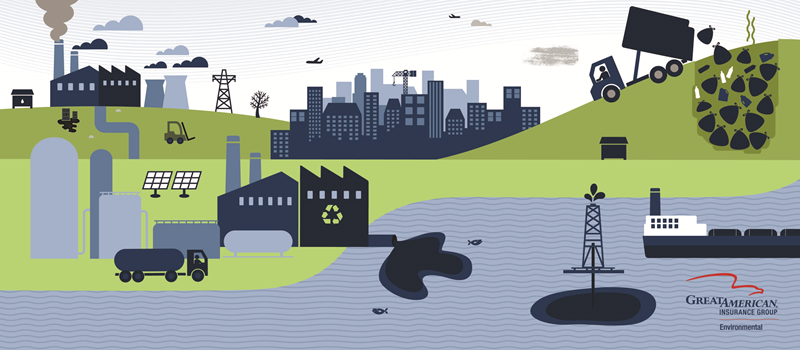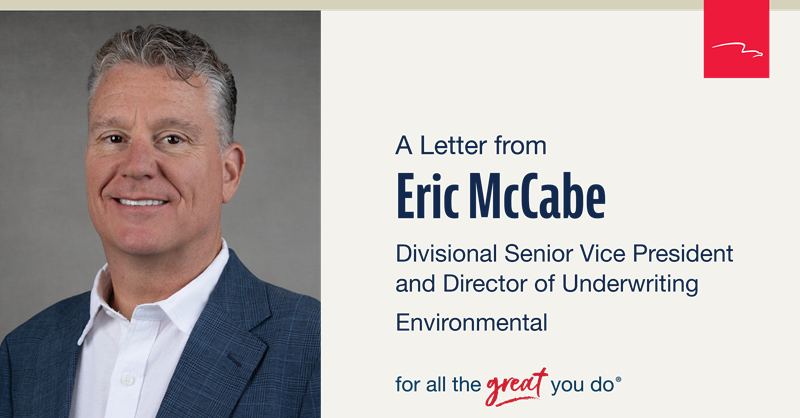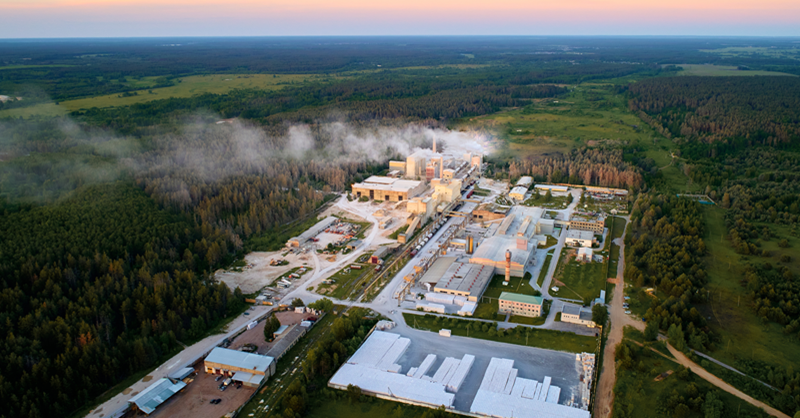Waste Management Riskopolis

Can you spot the environmental risks hiding in the scene below? Take a closer look at each one by clicking on the numbers.
Landfill
1. Property Contamination
Operators of a Construction and Demolition (C&D) waste landfill were sued by an adjacent property who alleged that contamination from the C&D landfill had migrated onto their land. The complaint alleged that C&D operator accepted various liquid wastes, which subsequently contaminated the groundwater, and therefore diminished their property’s value.
2. Unexpected Landfill Materials During Redevelopment
A developer purchased a former landfill as part of a larger brownfield re-development project. After purchasing the property and beginning the project, the developer discovered that landfill materials were present beyond the limits of the known, closed landfill cells. The material required excavation and off-site disposal prior to continuing with site development.
3. Landfill Redevelopment Hits A Snag
A former landfill, which received closure in the 1980s, was being redeveloped into a condominium complex. The proposed redevelopment triggered environmental regulators to request an extensive environmental assessment of the property, focusing on emerging chemicals of concern in groundwater and the potential risk of chemicals in soil vapor to future condominium residents.
4. Landfill Leachate Discharge Violation
An operating hazardous waste landfill discharged treated leachate to the sanitary sewer under an Industrial Waste Permit. Due to an operator error, the permitted discharge limits in the leachate sent to the sewer were exceeded for two months, and the landfill operator was assessed civil fines and penalties amounting to $25,000/day for every day of exceedance.
5. Dangerous Dust
A residential community located a half mile from a landfill sued the landfill operator, alleging the truck traffic related to the site operations resulted in the release of contaminated dust and caused nuisance levels of noise and odors.
6. A Dumpster Surprise
A waste hauling company maintained a contract with a public entity for waste pickup and distribution to a nearby landfill. While in the midst of loading waste, a container with an unknown liquid was encountered, resulting in a spill from the garbage vehicle onto the pavement and into a storm drain. The waste collection employee acted quickly to deploy the spill kit, but some material still entered the receiving waterway. The release affected both the soil around the garbage vehicle and the adjacent storm drain. Emergency response expenses to vacuum out the storm drain and excavate impacted soils reached $110,000.
7. Odor Complaint
Following a malfunction of a landfill gas collection system, a municipal waste landfill received multiple odor complaints from a nearby neighborhood and was fined by the state regulatory agency for permit violations associated with the gas collection system. Subsequently, the residents sued the landfill operator for property damage and bodily injury.
8. Closure/Post-Closure Financial Assurance
An operator of a new hazardous waste landfill was required to show adequate financial assurance for closure and post-closure obligations prior to commencing operation. Following review of the operator’s financial statements and technical information, a Closure-Post/Closure insurance policy was issued to meet the regulatory requirements.
Recycling Center
9. Suspicious Basement Odor
Residents in a crowded urban neighborhood, located near a solvent recycler, started to notice a suspicious odor in their basements. After investigation, it was determined that the vapors were caused by solvent contaminated groundwater underneath the recycling facility as a result of improper historical practices of storage disposal. The residents claimed the solvent vapors from their basements were both fire and health hazards that reduced their property values. Claims against the recycling facility for perceived bodily injury and diminution of property value were made.
10. Electronics Recycling Center
An electronics recycling center operated in a leased warehouse facility. Due to a downturn in demand for the electronic components, the tenant went bankrupt, and abandoned the collected electronics in the warehouse. Because the tenant was bankrupt (and had no environmental insurance), the building owner was required to manage the waste. The abandoned electronics required disposal as hazardous waste at a permitted regional landfill. In addition, the warehouse and air handling system needed to be decontaminated due to heavy metals in the ductwork. Total cleanup costs were in excess of $1,000,000.
Wastewater Treatment
11. Untreated Wastewater
A process tank at a recycling wastewater treatment plant malfunctioned. The tank discharged a large volume of untreated wastewater into a nearby stream, causing damage to many aquatic plants and fish. The local regulatory authority issued fines to the operator of the wastewater treatment plant for the unauthorized discharge. In addition, several local residents as well as environmental groups filed property damage suits.
12. Faulty Valve Leads to Evacuation
The operator of a wastewater treatment plant was in the process of receiving a shipment of chlorine bleach to use in the treatment process at the facility. The chlorine valve connecting the hose to the tank was not secured and a significant amount of chlorine bleach was released and ran down the parking area into a small culvert on a neighboring property. The chlorine vendor was able to close the valve, but the spill contaminated both the culvert and surrounding soil. Fumes from the release caused an adjacent manufacturing operation to be evacuated. The cost to neutralize the chlorine and remediate the spill was significant. Claims for cleanup fines, third party bodily injury and business interruptions were filed.
13. Contamination From Historical Operations
An old wastewater treatment plant had undergone several renovations throughout the years. Improper closure of an old clarifier and on-site surface impoundment had allowed gradual seepage into the groundwater. The contaminated groundwater was a central water supply for a neighboring community. Extensive groundwater remediation and emergency water supply for residents was required.
Energy Plant
14. Landfill Redevelopment to Solar Farm
A former closed landfill was converted to a solar farm to generate electricity. The operator used site and contractor pollution policies to facilitate the risk transfer from the municipality who owned the landfill and protect themselves during site redevelopment.
15. Waste to Energy Plant Odors
A new “waste to energy” plant which uses organic materials to generate electricity experienced unexpected odors during plant start-up. Due to the odor complaints from neighbors, the plant was required to shut down and was also assessed civil fines and penalties for permit non-compliance from the state air pollution authority. Nearby businesses and residences also sued the operator for bodily injury and property damages.
Warehouse Facility
16. Hazardous Liquid Waste
An unknown party illegally placed a container of hazardous liquid waste into a dumpster at a small warehouse facility. The container leaked and contaminated the contents of the load, which in turn contaminated the waste on the tipping floor of the transfer station. As a result, extensive legal fees and cleanup costs were incurred.
17. Contamination from Warehouse Fire
A fire occurred in the middle of the night at a warehouse facility. Responders to the fire discovered heavy smoke settling over nearby residential communities. It was determined that various hazardous materials were stored in the warehouse and the vapors from the fire could present a health hazard. After the fire was extinguished, testing revealed that contamination was present in the soils beneath and around the warehouse as a result of the contaminated fire suppression water and the fire-fighting foam that was used. Subsequent cleanup activities were required. Several claims alleging bodily injury due to inhalation of toxic fumes from the fire were also filed by nearby residents. The warehouse owner also incurred additional expenses associated with the defense and settlement.
18. Forklift Punctures Liquid Tote
A forklift operator moving a 250-gallon tote of paint outside of a warehouse accidently punctured the container. Because of heavy rains at the time, the released paint flowed into the onsite storm water retention pond. Although no paint was released off-site, the impacted pond needed to be emptied and cleaned, and the water required off-site disposal as industrial waste.
Hazardous Waste Storage, Disposal, Treatment Facilities
19. Solvent Laced Wash Water
A drum storage facility performed routine drum washing operations. Over time, solvent laced wash water migrated through cracks in the concrete and into the subsurface soils and groundwater. The plume of solvents traveled off site and contaminated a nearby municipal water supply well. Costly remedial technology had to be implemented into the well to provide safe drinking water. The municipality filed suit for cleanup costs and property damage.
20. Release During Flooding
A hazardous waste storage facility used to accumulate spent solvents and other hazardous materials in tanks and drums was flooded during torrential rains, resulting in a release of materials outside of secondary containment structures and offsite into an adjacent drainage. Contaminated rainwater, concrete, and soil were required to be remediated.
21. Fires spreading chemicals and contaminated water used to control the fire
A hazardous waste incinerator caught fire and the local fire department responded using aqueous film forming foam (AFFF) containing PFAS to extinguish the fire. The foam subsequently ran into an adjacent ditch. The chemical ingredients, which are now considered potentially toxic to humans, were absorbed in the soil resulting in costly soil remediation via excavation and disposal.
22. Storage of drums on unpaved ground instead of concrete pad with containment
A waste disposal facility stored drums containing hazardous materials on bare soil prior to being properly treated and disposed. Many of the drums had minor leaks due to years of chemical corrosion, resulting in contaminants leaking into the soil and subsequently migrating into the shallow water aquifer, requiring extensive groundwater testing, remediation and long term monitoring.
23. Illicit abandonment of drums if insured goes bankrupt
The owners of a hazardous waste storage facility went into bankruptcy resulting in the local environmental agency to hire a remediation contractor to properly close the site. It was determined that the owners had been improperly stockpiling drums for many months prior to bankruptcy, requiring the contractor to arrange for shipping of the drums to an operating licensed facility.
24. Treatment of incompatible chemicals creating issues in the process resulting in an explosion
Workers at a treatment facility mistakenly added incompatible chemicals into a chemical reactor resulting in significant pressure buildup and an explosion. The explosion released a chemical vapor cloud that injured workers at the plant and residents in the area. Nearby businesses were also evacuated, resulting in costly business interruption claims.









.png?sfvrsn=396e21b1_2)




